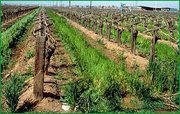Westside Alluvial Fans and Terraces (Bailey)
Contents
Lithology and Stratigraphy
This subsection contains mostly Quaternary alluvium, and some Plio-Pleistocene sediments. The alluvium is predominantly from sedimentary rocks sources in the Coast Ranges. There are small areas of Eocene, Miocene, and Pliocene sedimentary rocks.
Geomorphology
This subsection is on very gently to gently sloping terraces and alluvial fans. The San Joaquin Valley is asymmetrical, with shorter and steeper alluvial fans adjacent to the Coast Ranges than adjacent to the Sierra Nevada. Also, most of the drainage from the southern Coast Ranges is toward the Pacific Ocean, so there are few large streams draining across the terraces and alluvial fans on the west side of the San Joaquin Valley. The subsection elevation range is from 0 to about 1500 feet. Fluvial erosion and deposition are the main geomorphic processes.
Soils
The soils are Typic Xerofluvents, Typic and Calcixerollic Xerochrepts, Calcic and Aquic Haploxerolls, Typic and Mollic Haploxeralfs, Typic Chromoxererts, Typic and Chromic Pelloxererts, Aquic Natrixeralfs and Typic Palexeralfs. In drier areas near the southern end of the subsection there are Torriorthents, Camborthids, Haplargids, and Natrargids. Xeropsamments predominate in the Antioch dunes at the north end of the subsection. Most of the soils are well drained, but some are somewhat poorly well drained. Calcium carbonates, and even sodium, accumulate in some of the soils. Soil temperature regimes are thermic. Soil moisture regimes are xeric, and, in the southern end of the subsection, aridic.
Vegetation
The predominant natural plant communities are Needlegrass grasslands, and, in drier areas, California annual grass series. There are some Valley oak series and Northern claypan vernal pools.
Characteristic series by lifeform include:
Climate
The mean annual precipitation is about 8 to 16 inches. It is practically all rain. Precipitation increases both toward the mountains of the southern California Coast Ranges and toward the northern end of the subsection. Mean annual temperature is about 59° to 62° F. The mean freeze-free period is about 250 to 275 days.
Surface Water
Streams in this subsection drain to the San Joaquin River. All but the larger streams are generally dry during the summer. There are no lakes, but there is temporary ponding in vernal pools on Pleistocene terraces.
